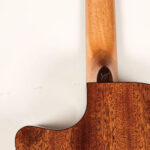Determining whether a guitar is designed for steel strings is crucial for optimal playability and sound. While some manufacturers might use similar construction methods for both nylon and steel-string guitars, key differences exist, primarily noticeable in the hardware. Understanding these distinctions ensures you’re using the Best Guitar Steel Strings on a compatible instrument.
One of the easiest ways to identify a guitar intended for steel strings is to examine the tuning machines. Steel-string guitars typically feature tuning posts made of metal, and these posts are usually smaller in diameter. These metal posts are designed to withstand the higher tension of steel strings. Nylon-string guitars, in contrast, utilize larger tuning posts, often made of plastic, within a slotted headstock design.
The guitar in the image clearly displays a headstock equipped with steel string tuning machines, characterized by metal posts. However, the action, or string height, appears to be high, suggesting potential setup issues despite being designed for steel strings. This high action could be due to less expensive construction methods.
If you find a guitar designed for steel strings but struggling with playability, especially high action, several options exist before seeking professional help. Switching to extra light gauge steel strings, sometimes even gauges intended for electric guitars, can significantly reduce string tension. While this might slightly compromise the guitar’s overall volume and tone, it can make the instrument considerably more playable.
Another possibility, although more involved, is to consider using nylon strings. This conversion would necessitate adjustments, primarily widening the nut slots to accommodate the thicker nylon strings. Additionally, the saddle height might need adjustment, and often, lowering it can improve playability. Modifying the bridge itself, by deepening the saddle slot or reshaping the forward wood section, can further lower the action at the bridge.
Experimenting with string changes and minor adjustments can be a worthwhile endeavor, especially given the potential to improve a guitar’s playability with minimal investment. At best, these efforts can transform an unplayable guitar into a functional instrument. In a worst-case scenario, if modifications render the guitar unplayable, it could still be repurposed creatively.


